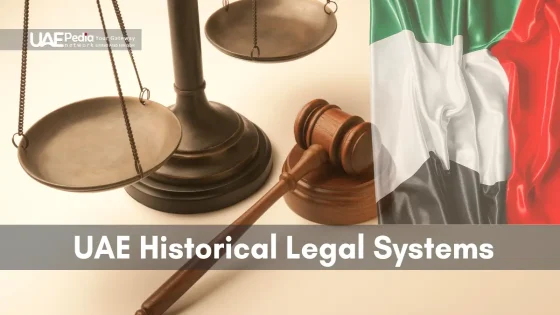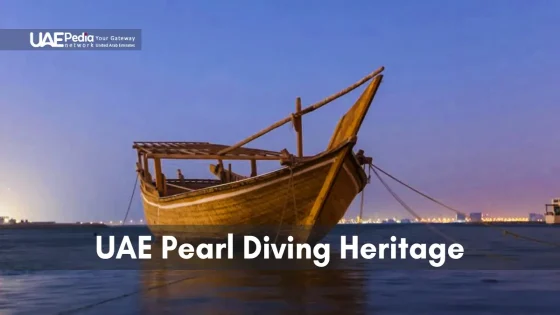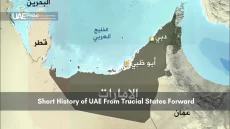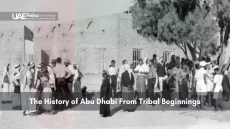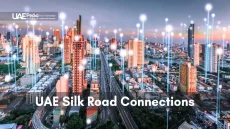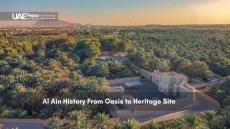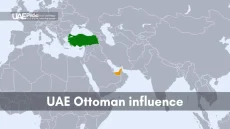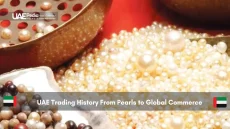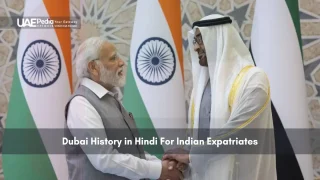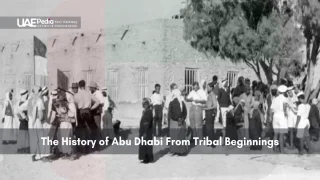Did you know the sands beneath Abu Dhabi’s glittering towers hold secrets older than Rome? Archaeologists found stone tools here dating back 100,000 years—proof that this wasn’t always a land of futuristic marvels. Let’s wander through time to uncover how scattered Bedouin camps evolved into a global hub, shaped by tribal wisdom and the relentless Gulf sun.
Long before skyscrapers, clans gathered around ghayl (freshwater springs), their survival tied to the land’s harsh beauty. These early communities weren’t just surviving—they thrived through pearl diving and trade, laying foundations for today’s economy. The name “Abu Dhabi” itself comes from local lore about a gazelle leading hunters to life-giving water—a story etched into the city’s identity.
What’s truly fascinating? The same tribal values of unity and resourcefulness now pulse through the capital’s veins. We’ll show you hidden wells where ancestors drew water and share how ancient trade routes mirror modern souks. Ready to trace this extraordinary journey?
Here’s what you’ll discover:
- How 100,000-year-old artifacts redefine the region’s timeline
- The ingenious ways tribes harnessed desert resources
- Why pearl diving shaped early economic networks
- The folklore behind the name “Abu Dhabi”
Regional Beginnings and Tribal Roots
Imagine standing where desert whispers once guided tribes to unity—centuries before luxury hotels dotted the coast. This land’s story pulses through the Bani Yas, a powerhouse tribe whose alliances shaped Abu Dhabi’s DNA.
Sandstone Diplomats: The Bani Yas Blueprint
Originating from Liwa’s golden dunes, the Bani Yas mastered survival through strategic alliances. By the 1700s, they’d become the region’s glue—pearl divers, camel breeders, and date farmers working as one. Leaders like Sheikh Dhiyab bin Isa (ancestor to Zayed bin Sultan Al Nahyan) forged bonds that turned scattered clans into a force.
Qasr Al Hosn: Where Walls Held Wisdom
Built in 1761 as a watchtower, this sandy fortress evolved into Abu Dhabi’s beating heart. Inside its coral-stone walls:
| Era | Role | Significance |
|---|---|---|
| 1790s | Defense post | Protected freshwater wells |
| 1820s | Royal residence | Hosted tribal councils |
| 1930s | Community hub | Stored vital trade records |
Today, its restored arches still echo with decisions that birthed a nation. The same courtyard where Sheikh Shakhbut bin Dhiyab strategized now hosts heritage festivals—proof that tribal unity remains the city’s compass.
The Tribal Era: Life Before Oil
Picture mornings starting with the shrill cry of seabirds—nature’s alarm clock for pearl divers preparing wooden dhows. Long before oil transformed the skyline, Abu Dhabi’s people thrived on ingenuity, turning tidal rhythms into survival strategies. Let’s step into their sandals.
Cultural Traditions and Daily Living
Sunup meant teamwork. Men sailed through turquoise waters, free-diving 30 meters with nose clips made of turtle shell. Women wove palm fronds into baskets while sharing folklore under shaded arish huts. Every sunset brought communal feasts—fresh fish grilled over smokeless fires, dates stuffed with almonds.
Pearl diving wasn’t just work—it was a rite of passage. Divers sang rhythmic work songs to coordinate dives, their lungs burning as they scooped oysters from seabeds. Successful hauls fed families and fueled maritime trade networks, exchanging gems for spices and textiles.
Fishing villages buzzed with purpose. Nets woven from camel hair trapped kingfish, while wooden traps called gargoor snared shrimp. Kids learned navigation by starlight, their lessons blending survival skills with poetry about the sea.
These traditions still whisper through modern souks. Watch artisans string pearls at Heritage Village, or join elders brewing karak chai—their stories bridging past and present. Resilience wasn’t just survival here—it was art.
Decoding the history of abudhabi
What if we told you Abu Dhabi’s islands hide more than luxury resorts? Archaeologists recently unearthed 4,500-year-old stone cups near Delma Island—silent witnesses to thriving Bronze Age communities. These finds rewrite what we know about life in the United Arab Emirates long before oil wealth.
Archaeological Discoveries and Early Evidence
Let’s brush off the sand. The Umm Al Nar culture left behind pottery shards and burial sites dating to 2500 BCE—proof of sophisticated trade networks. On Marawah Island, a 7,000-year-old settlement revealed stone houses aligned with seasonal winds. Carbon dating shows these islanders traded with Mesopotamia and the Indus Valley.
Key finds include:
- Pearl-encrusted jewelry from 3000 BCE
- Bronze tools used for date cultivation
- Ancient fire pits with preserved fish bones
Cultural Narratives Passed Through Generations
While excavators dig, storytellers keep older truths alive. One enduring tale speaks of a lost freshwater spring beneath Abu Dhabi’s main island—a hidden lifeline during droughts. Elders still recount how their ancestors navigated using star patterns called al-thurayya (the Pleiades).
These oral histories align with artifacts. A 2022 study found 3rd-millennium BCE fishing nets near locations described in Bedouin poems. As one Emirati historian noted: “Our grandparents’ stories are maps written in wind and water.”
From Bronze Age traders to pearl divers, each generation left markers on this island chain. Today, their legacy shapes the United Arab Emirates’ identity—bridging desert wisdom with global ambition.
The Rise of the Al Nahyan Family in Abu Dhabi
Ever wonder how a desert tribe’s wisdom built a global powerhouse? The Al Nahyan dynasty didn’t just rule—they reimagined leadership. Emerging from the Bani Yas confederation, this family turned arid sands into a blueprint for modern statehood through unity and vision.
Sheikh Zayed’s Hands-On Governance
Sheikh Zayed bin Sultan Al Nahyan became the face of progress long before oil wealth. In the 1940s, he’d ride his Land Rover to remote villages, trading stories under date palms. “A ruler who doesn’t know his people’s hunger can’t feed their hopes,” he once told Bedouin elders. This grassroots approach fueled projects like:
- Expanding freshwater access via ancient falaj irrigation systems
- Establishing the region’s first formal education programs
- Negotiating peace between rival tribes
Threads of Tradition in Modern Fabric
The Nahyan family’s secret? Treating tribal values like GPS coordinates. Today’s leaders still host open majlis councils where citizens voice concerns—a practice dating to 18th-century desert gatherings. When Sheikh Zayed became UAE President in 1971, he insisted on keeping this tradition alive, blending ancestral wisdom with global ambitions.
Bin Zayed Al Nahyan, current Crown Prince, often cites his father’s motto: “Wealth isn’t money—it’s people who build nations.” From pearl-era diplomacy to AI-driven governance, the family’s legacy proves desert roots can anchor skyscrapers.
Economic Transformations: From Pearl Trade to Oil Boom
What if a single natural resource could flip a desert economy twice? Abu Dhabi’s story isn’t just about oil—it’s a masterclass in reinvention. Let’s explore how pearling dhows gave way to drilling rigs, rewriting the region’s destiny.
The Flourishing Pearl Diving Era
Pearl divers once ruled these waters. By the early 1900s, over 1,200 ships sailed from the emirate, their crews hauling oysters that glittered like liquid moonlight. At its peak, the trade accounted for 95% of local income—until cultured pearls flooded global markets in the 1930s.
Innovation kept communities afloat. Artisans repurposed diving equipment for fishing, while merchants pivoted to date farming. This grit laid groundwork for what came next—a resource deeper than any oyster bed.
Oil Discovery and Its Revolutionary Impact
Das Island’s 1958 oil strike changed everything. Suddenly, camel trains shared roads with tanker trucks. When the first crude shipment sailed in 1962, it sparked a chain reaction:
- Schools and hospitals sprouted where desert camps once stood
- Ancient trade routes evolved into global shipping lanes
- Sovereign wealth funds turned black gold into sustainable investments
Sheikh Zayed didn’t just spend oil wealth—he invested it. Revenues built roads, airports, and the Masdar City renewable energy hub. As one engineer on the 1958 drill team recalled: “We weren’t just finding oil—we were unlocking futures.”
Today, the emirate balances its roots with ambition. Traditional dhow-building yards operate near offshore rigs, while global trade partnerships echo ancient maritime networks. Even pearl diving survives—not as necessity, but as heritage celebrated in museums and cultural festivals.
Modern Architectural and Urban Developments
Ever seen a 200-year-old fort reflected in a glass skyscraper? Abu Dhabi’s skyline tells twin tales—ancient wisdom etched in stone and tomorrow’s dreams cast in steel. The city’s blueprint masterfully stitches Bedouin ingenuity with 21st-century vision, creating spaces where heritage whispers through futuristic designs.
Iconic Constructions: From Forts to Skyscrapers
Qasr Al Hosn’s coral walls now share the horizon with Etihad Towers’ swirling silhouette. This architectural dance spans centuries:
| Feature | Traditional | Modern |
|---|---|---|
| Materials | Coral stone, palm wood | Reinforced glass, carbon fiber |
| Purpose | Community protection | Global connectivity |
| Design Influence | Desert winds | Mathematical algorithms |
The Louvre Abu Dhabi epitomizes this blend. Its floating dome—patterned after palm fronds—filters sunlight like ancient arish roofs once did. Meanwhile, Al Bahr Towers’ responsive façades mimic traditional mashrabiya screens, proving smart tech can honor ancestry.
Urban Planning and Contemporary Design
Abu Dhabi Plan 2030 reshapes the city’s DNA. Saadiyat Island transforms from empty sands to cultural district—museums neighbor protected turtle nesting sites. Walk the Corniche today: cycle paths trace old pearl diving routes, while mangrove parks buffer futuristic towers.
Urban planners face delicious challenges. How do you preserve a fishing village’s soul while adding metro lines? Their answer: heritage zones protected amid innovation hubs. As one architect told us: “We build upward, but our foundations dig deep into tradition.”
Governance and Political Evolution
How does a constellation of desert tribes become a united global force? The answer lies in a political metamorphosis that turned camel-wool tents into ministerial offices—all while keeping ancestral wisdom at its core. Let’s unpack how tribal majlis councils evolved into one of the Middle East’s most stable governments.
Formation of the UAE and Political Milestones
December 2, 1971, wasn’t just a date—it was a declaration. Seven emirates united under Sheikh Zayed bin Sultan Al Nahyan, the first ruler abu dhabi to serve as UAE President. But the groundwork began earlier:
| Treaty | Year | Impact |
|---|---|---|
| Exclusive Agreement | 1892 | Established British protection |
| Union Agreement | 1971 | Created federal structure |
Sheikh Khalifa bin Zayed Al Nahyan later expanded this vision. As ruler abu dhabi from 2004, he championed education reforms and infrastructure projects, declaring: “Our unity is our compass—it guides both tradition and progress.”
Transition from Tribal Leadership to Modern Government
Traditional shura (consultation) practices didn’t vanish—they transformed. Today’s Federal National Council blends elected members with appointed advisors, mirroring ancient tribal consensus-building. Key shifts include:
- Local leaders becoming federal ministers
- Customary law merging with modern judiciary
- Oil revenues funding universal healthcare
This evolution proves governance here isn’t about replacing the past—it’s about rewiring it. As you walk past the Presidential Palace’s gleaming domes, remember: every policy paper here carries echoes of desert diplomacy.
Geographical Significance and Regional Influence
Ever noticed how Abu Dhabi’s coastline resembles a chess piece poised for strategic moves? This T-shaped island juts into the Persian Gulf like nature’s own docking station, flanked by 700 kilometers of coastline that once guided pearl ships and now welcome supertankers. Its position at the crossroads of three continents makes it a geopolitical linchpin, where desert meets deepwater channels.
Mapping Abu Dhabi’s Strategic Landscape
The emirate’s land tells twin tales—arid interiors rich in oil reserves and salt flats hiding ancient trade paths. Mangrove forests along the coast act as natural breakwaters, protecting harbors that have hosted merchants from Mesopotamia to Mumbai. Key resources like freshwater springs and petroleum deposits cluster along geological fault lines, shaping settlement patterns for millennia.
Influence of the Persian Gulf and Surrounding Regions
Look at any map: Abu Dhabi sits within 4 hours’ flight of 4 billion people. The Gulf’s shallow waters enabled historic pearl diving, while modern dredging created Khalifa Port—today’s gateway linking Asia, Africa, and Europe. Trade winds that once filled dhow sails now propel the region’s air cargo industry.
| Historical Advantage | Modern Equivalent |
|---|---|
| Natural harbors | Deepwater ports |
| Coastal trade routes | Global shipping lanes |
| Freshwater springs | Desalination plants |
This geography doesn’t just connect markets—it forges alliances. Proximity to Saudi Arabia and Qatar positions the Arab Emirates as a regional mediator, while offshore gas fields strengthen energy partnerships worldwide. As one urban planner remarked: “Our sand is currency, our shores are chessboards.”
Cultural Legacy and Societal Changes
Have you tasted coffee brewed with cardamom in a Bedouin tent beside a hyperloop station? Abu Dhabi’s heartbeat thrives in these contrasts—where elders still recite Nabati poetry while Gen Z influencers livestream from heritage festivals. The Al Nahyan family’s vision anchors this dance between tradition and tomorrow.
Threads Woven Through Time
Sheikh Zayed bin Sultan Al Nahyan’s voice still echoes in daily life. His famous decree—“A nation without roots is like a tree without water”—shapes everything from architecture to education. Today’s youth learn archery at Qasr Al Hosn while coding robots, their kanduras fluttering as they debug algorithms.
Key traditions endure through reinvention:
- Majlis gatherings now discuss AI ethics alongside tribal history
- Date harvest festivals feature drone-assisted palm pollination
- Pearl diving songs remixed into electronic anthems
Sheikh Khalifa bin Zayed championed this balance, funding UNESCO-recognized heritage sites while launching space programs. His leadership proved modernity doesn’t erase identity—it amplifies it.
Challenges exist, of course. Skyscrapers tower over fishing villages, and global brands outshine local artisans. Yet walk through Mina Zayed’s fish market at dawn—you’ll hear hagglers using iPhones to check prices, their laughter unchanged from pearl-trading days. As one silversmith told me: “We polish old designs until they reflect new light.”
Abu Dhabi Today: A Thriving Capital
Where else can you find AI-powered taxis whisking past UNESCO-listed date palm groves? The capital of the United Arab Emirates pulses with contradictions that work—a skyline of glass spires casting shadows on coral-stone forts. Over 1.5 million residents now call this desert jewel home, drawn by opportunities spanning blockchain startups and heritage conservation.
Economic Growth and Global Integration
Abu Dhabi’s GDP surged 9.3% last year, fueled by smart diversification. The ruling family’s Vision 2030 plan turns oil wealth into renewable energy hubs and tech incubators. Key sectors driving progress:
| Sector | Contribution | Innovation |
|---|---|---|
| Energy | 35% of GDP | World’s largest solar farm |
| Tourism | 12 million visitors/year | Louvre & Guggenheim partnerships |
| Tech | $2B startup funding | AI-driven smart city initiatives |
Global investors pour into free zones like Masdar City, where solar panels power data centers. Yet traditional markets thrive too—the dates sold at Mina Port today reach 87 countries.
Balancing Heritage and Modernity
Sheikh Zayed Nahyan’s legacy lives in unexpected ways. At Qasr Al Watan Palace, holograms of pearl divers share walls with treaties signed by world leaders. The ruling family funds projects preserving Emirati dialects while launching Arabic-language coding bootcamps.
Three streets over from robot-assisted falcon hospitals, artisans still stitch sadu textiles using methods unchanged for centuries. As Crown Prince Mohamed bin Zayed notes: “Progress isn’t about erasing footprints—it’s about walking farther while remembering where the path began.”
This capital doesn’t just host the future—it rewrites it, one algorithm and palm-frond basket at a time.
Final Reflections on Abu Dhabi’s Journey
How do you honor 100,000 years of wisdom while racing toward tomorrow? The answer glitters in Abu Dhabi’s skyline—where coral-stone watchtowers stand sentinel over Formula 1 circuits. This emirate didn’t just evolve—it reimagined itself across centuries, blending Bedouin grit with visionary leaps.
From Bronze Age traders to AI-driven smart cities, every era left fingerprints. Yas Island embodies this spirit. Once a quiet fishing zone, it now thrums with Ferrari World’s rollercoasters and mangrove conservation labs. Yet wander its shores—you’ll still find elders teaching star navigation to kids coding robots.
The Al Nahyan dynasty’s secret? Treating tradition as rocket fuel. Ancient irrigation systems inspire water-saving tech, while pearl divers’ songs echo in renewable energy anthems. Even Qasr Al Hosn’s restored walls host debates about Mars colonization.
Abu Dhabi today isn’t choosing between past and future—it’s weaving them. As you sip karak chai near Louvre Abu Dhabi’s fractal dome, ponder this: What will the next century unveil? One truth remains—every innovation here carries whispers of those who first dared to thrive in the dunes.
The Bani Yas tribe, led by the Al Nahyan family, transformed Abu Dhabi from a coastal settlement into a thriving hub. Their mastery of desert survival, trade routes, and maritime skills laid the groundwork for the emirate’s early economy and social structure.
Sheikh Zayed unified tribal alliances, prioritized education and healthcare, and championed sustainable development. His vision turned the emirate into a modern nation while preserving Bedouin traditions—think falconry festivals alongside skyscrapers!
Built in the 1790s as a watchtower, Qasr Al Hosn evolved into the ruling family’s seat and a community gathering spot. Its coral-stone walls whisper tales of pearl traders, tribal councils, and the emirate’s first formal governance.
When Japan’s cultured pearls flooded markets in the 1930s, the industry collapsed. But in 1958, the Umm Shaif oilfield discovery sparked a revolution—petrodollars funded infrastructure, schools, and the UAE’s 1971 federation.
From restoring Al Ain oases to hosting Heritage Week, the emirate weaves tradition into daily life. You’ll smell frankincense in malls, hear Arabic poetry at Louvre Abu Dhabi, and find elders sharing stories in waterfront majlis spaces.
Nestled between the Persian Gulf’s trade lanes and the Empty Quarter’s dunes, Abu Dhabi became a crossroads for spices, pearls, and now global business. Its ports and airports link East-West markets, while oil reserves anchor geopolitical influence.

